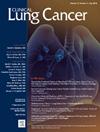Comparison of Sublobar Resection and Proton Therapy for Early-Stage Non–small Cell Lung Cancer
IF 3.3
3区 医学
Q2 ONCOLOGY
引用次数: 0
Abstract
Background
For early-stage lung cancer, sublobar resection (SLR) is an alternative to lobectomy, which is the standard treatment. Recently, proton therapy (PT) is being increasingly used, even in patients with operable lung cancer, as an attractive alternative to conventional radiation therapy. Thus, we performed propensity score matching (PSM) to compare the outcomes of SLR and PT in patients with early-stage non–small cell lung cancer (NSCLC).
Patients and Methods
A total of 202 patients with histologically confirmed clinical stage 0 or I peripheral NSCLC who underwent SLR or PT at our institution between July 2013 and December 2021 were included in the study. PSM was performed to adjust for confounding effects.
Results
PSM generated a cohort of 104 patients who were treated with SLR (n = 52) or PT (n = 52). We observed no significant differences in overall survival (OS) (P = .77), cause-specific survival (P = .43), recurrence-free survival (RFS) (P = .35), local tumor control (P = .51), regional lymph node tumor control (P = .99), and distant tumor control (P = .37). The 5-year OS and 5-year RFS were 85.2% and 73.7%, respectively, in the SLR group and 83.4% and 70.2%, respectively, in the PT group.
Conclusion
This study demonstrated no significant differences in the prognosis or tumor control efficacy between SLR and PT in patients with histologically confirmed clinical stage 0 or I peripheral NSCLC. Further studies are warranted to clarify the comparative effectiveness of SLR and PT across various patient risk strata.
叶下切除与质子治疗早期非小细胞肺癌的比较。
背景:对于早期肺癌,肺叶下切除术(SLR)是替代肺叶切除术的标准治疗方法。最近,质子治疗(PT)作为传统放射治疗的一种有吸引力的替代方案,被越来越多地使用,甚至在可手术的肺癌患者中也是如此。因此,我们采用倾向评分匹配(PSM)来比较SLR和PT在早期非小细胞肺癌(NSCLC)患者中的结果。患者和方法:2013年7月至2021年12月期间在我院接受SLR或PT治疗的组织学证实的临床0期或I期外周性NSCLC患者共202例纳入研究。PSM用于校正混杂效应。结果:PSM产生了104例接受SLR (n = 52)或PT (n = 52)治疗的患者。我们观察到总生存率(OS) (P = 0.77)、病因特异性生存率(P = 0.43)、无复发生存率(RFS) (P = 0.35)、局部肿瘤控制(P = 0.51)、局部淋巴结肿瘤控制(P = 0.99)和远端肿瘤控制(P = 0.37)无显著差异。SLR组5年OS和5年RFS分别为85.2%和73.7%,PT组5年OS和RFS分别为83.4%和70.2%。结论:本研究显示SLR和PT在组织学证实的临床0期或I期非小细胞肺癌患者的预后和肿瘤控制效果无显著差异。需要进一步的研究来阐明SLR和PT在不同患者风险层的比较有效性。
本文章由计算机程序翻译,如有差异,请以英文原文为准。
求助全文
约1分钟内获得全文
求助全文
来源期刊

Clinical lung cancer
医学-肿瘤学
CiteScore
7.00
自引率
2.80%
发文量
159
审稿时长
24 days
期刊介绍:
Clinical Lung Cancer is a peer-reviewed bimonthly journal that publishes original articles describing various aspects of clinical and translational research of lung cancer. Clinical Lung Cancer is devoted to articles on detection, diagnosis, prevention, and treatment of lung cancer. The main emphasis is on recent scientific developments in all areas related to lung cancer. Specific areas of interest include clinical research and mechanistic approaches; drug sensitivity and resistance; gene and antisense therapy; pathology, markers, and prognostic indicators; chemoprevention strategies; multimodality therapy; and integration of various approaches.
 求助内容:
求助内容: 应助结果提醒方式:
应助结果提醒方式:


